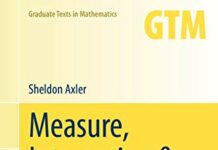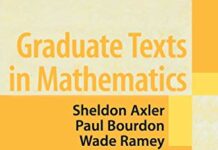
Ebook Info
- Published: 2004
- Number of pages: 251 pages
- Format: PDF
- File Size: 1.25 MB
- Authors: Sheldon Axler
Description
This text for a second course in linear algebra, aimed at math majors and graduates, adopts a novel approach by banishing determinants to the end of the book and focusing on understanding the structure of linear operators on vector spaces. The author has taken unusual care to motivate concepts and to simplify proofs. For example, the book presents – without having defined determinants – a clean proof that every linear operator on a finite-dimensional complex vector space has an eigenvalue. The book starts by discussing vector spaces, linear independence, span, basics, and dimension. Students are introduced to inner-product spaces in the first half of the book and shortly thereafter to the finite- dimensional spectral theorem. A variety of interesting exercises in each chapter helps students understand and manipulate the objects of linear algebra. This second edition features new chapters on diagonal matrices, on linear functionals and adjoints, and on the spectral theorem; some sections, such as those on self-adjoint and normal operators, have been entirely rewritten; and hundreds of minor improvements have been made throughout the text.
User’s Reviews
Editorial Reviews: Review From the reviews:ZENTRALBLATT MATH “This second edition of an almost determinant-free, none the less remarkably far-reaching and didactically masterly undergraduate text on linear algebra has undergone some substantial improvements. First of all, the sections on selfadjoint operators, normal operators, and the spectral theorem have been rewritten, methodically rearranged, and thus evidently simplified. Secondly, the section on orthogonal projections on inner-product spaces has been extended by taking up the application to minimization problems in geometry and analysis. Furthermore, several proofs have been simplified, and incidentally made more general and elegant (e.g., the proof of the trigonalizability of operators on finite-dimensional complex vector spaces, or the proof of the existence of a Jordan normal form for a nilpotent operator). Finally, apart from many other minor improvements and corrections throughout the entire text, several new examples and new exercises have been worked in. However, no mitigation has been granted to determinants. Altogether, with the present second edition of his text, the author has succeeded to make this an even better book.”AMERICAN MATHEMATICAL MONTHLY”The determinant-free proofs are elegant and intuitive.”CHOICE “Every discipline of higher mathematics evinces the profound importance of linear algebra in some way, either for the power derived from its techniques or the inspiration offered by its concepts. Axler demotes determinants (usually quite a central technique in the finite dimensional setting, though marginal in infinite dimensions) to a minor role. To so consistently do without determinants constitutes a tour de forces in the service of simplicity and clarity; these are also well served by the general precision of Axler’s prose. Students with a view towards applied mathematics, analysis, or operator theory will be well served. The most original linear algebra book to appear in years, it certainly belongs in every undergraduate library.” ZENTRALBLATT MATH “Altogether, the text is a didactic masterpiece.”From the reviews of the second edition:S. AxlerLinear Algebra Done Right”The most original linear algebra book to appear in years, it certainly belongs in every undergraduate library.”—CHOICE”A didactic masterpiece.”—ZENTRALBLATT MATH“This book can be thought of as a very pure-math version of linear algebra … . it focuses on linear operators, primarily in finite-dimensional spaces … . Axler has come up with some very slick proofs of things that … makes the book interesting for mathematicians. The book is also very clearly written and fairly leisurely. … Axler concentrates on the properties of linear operators, and doesn’t introduce other concepts unless they’re really necessary.” (Allen Stenger, The Mathematical Association of America, December, 2010)
Reviews from Amazon users which were colected at the time this book was published on the website:
⭐What an awful title. I guess Sheldon Axler decided on the ungrammatical “Linear Algebra Done Right” to avoid “Linear Algebra Done Properly” or something similar, which would have sounded intolerably arrogant. He justifies this title repeatedly by rather obnoxiously flaunting his determinant-free proof that operators on complex (or real, odd-dimensional) vector spaces have an eigenvalue. (It’s pretty cool, but I’ve seen cooler constructions, and I’m not even a mathematician.) He also often makes other snarky jabs at the unnamed body of traditional linear algebra texts.Read the book, and you will forgive him on all counts.Other reviewers have already been thorough in their praise/criticism of Axler’s elegant exposition that deprecates matrices and determinants. The highlight in my view is how Axler cleans up proofs by simplifying notation and carefully abstracting common algorithms into lemmas (like 2.4, his Linear Dependence Lemma) that are used over and over. This greatly improves readability and promotes the development of intuition. Some of his nonstandard choices of notation are used to such great pedagogical effect that they seem to threaten to redefine what is standard. The prose is correspondingly clear, concise, and full of useful motivation for difficult points. The formatting is impeccable – definitions, equations, inequalities, and theorems/lemmas are all given a uniform numbering system, making them easy and unambiguous to cite. Subsidiary comments are relegated to the margins of the book, keeping the main line of exposition free of digressions. The text is quite shockingly free of errors. Finally, the layout has a clean but cheerful flower-power look that reminds the reader that math is about beauty and fun – not just intimidating formalism.Axler’s refusal to refer directly to others for inspiration (he seemingly proudly omits a bibliography) does cause some warts. For instance, when looking at orthogonal projections for optimization, he asks the reader to do inner-product gymnastics in polynomial space on [0,1] instead of on [-1,1]. The latter choice gives rise to the all-important Legendre polynomials, whose symmetry properties are much clearer.Also, while the pristine algebraic presentation was remarkable, I’d have liked to see more geometric insight in places. I got into this book because my undergraduate linear algebra experience, with Apostol Vol. 2, was so frustrating – all of the sweeping and magical structure theorems of self-adjoint operators and so forth seemed to reduce to incomprehensible index-pushing. For me, what finally cleared up these notions to me was drawing, on graph paper, the fate of vectors in R^2 under various linear operators. This was not in the book, but Axler’s inclusion of the theory of polar and singular-value decompositions did give some important tools to help unravel these beautiful but elusive issues. Finally, the crystal clarity of the exposition rolls off in Chapters 8 and 9 when getting into the structure theory of general operators on real and complex vector spaces. The symbols get more abstruse, and the arguments get more murky. But I’ve never seen another author make anything but a mess of, say, the proof of Jordan form. It is hard stuff, and it is not fair to be too hard on authors for failing to make it look easy.The end-of-chapter problems are abundant enough to give a good feel for the material, with an appropriate range of difficulties for an advanced undergraduate book. There are enough of the routine computations and simple proofs that familiarize readers with the new machinery they are learning, but at least a proof or two in each chapter require creative constructions to complete. I just finished the last of the 224 problems, a task that took me five years’ worth of sporadic effort in my free time and vacations as a high school math teacher and then as a graduate student in chemistry. A few problems took me the better part of a year to figure out, though this was without the benefit of collaboration. I found the equivalent of at one sequence of problems (problems 6-8 in Chapter 6) as a starred problem in a graduate functional analysis text. I consider myself a good but not award-winning math student, so this indicates that the problems are consistently tractable but can get pretty tough in places. Axler does not mark his most difficult problems as such; for the teacher assigning Axler’s problems for a course, then, it is imperative to work through the problems beforehand.All told, this is quite a remarkable book. I now feel like I understand linear algebra, something I couldn’t say when I first studied the subject eight years ago. The title does not do it justice.
⭐This is an excellent book but it’s not for everyone. Math majors in particular will benefit from this book the most, while those who simply need a quick, intuitive introduction to the principle theorems and matrix operations of linear algebra would be served best elsewhere. Unfortunately you’re probably not going to realize which group you belong to until either 1) you take your first upper level math class and realize that your understanding of finite-dimensional vector spaces provided to you by your standard undergraduate LA class is grossly inadequate for dealing with subjects like real and numerical analysis or 2) you buy this book in order to help you learn basic LA calculations that depend on algorithmic matrix manipulation and determinants and are incredibly frustrated and disappointed with it.If you’re an undergraduate who planning on taking any higher level math courses in subjects like numerical analysis, mathematical statistics, or abstract algebra, do yourself a favor and get this book! It will totally help you to understand the underlying principles of concepts like continuous functions on multidimensional spaces, hypothesis testing, and abstract fields. This book will also be extremely helpful if you are going into any variation of computational mathematics where you have to use programming languages like MatLab or R that already assume you have a good working knowledge of finite-dimensional vector spaces (not to be mistaken with standard matrix operations).On the other hand, if you are just having trouble following along in your standard undergraduate LA class or are looking for a good study aid or textbook supplement I would recommend something more along the lines of Linear Algebra by Strange. A quick way to know if this is you, just ask yourself, “Do the problems I’m trying to solve require the use of determinants?” If the answer is yes, then this is probably not the book for you.
⭐First things first: this is intended for a second course in the subject. This could not be made more clear, being written on the back cover and the foreword. Still, about half of the one and two star reviewers somehow missed this and (surprise) didn’t enjoy the book.Anyway, this is one of several sources from which I learned Linear Algebra, the others being Lay and Leon for my first exposure, and Shilov as a companion to this book for my second exposure. Top that off with Professor Strang’s recorded lectures and I really should know much more than I actually do! Although the word is used a lot, this book really is elegant. The first three or four chapters cover the basics and are done well, but I think the book really takes off at the start of chapter 5 (I know a lot about determinants from Shilov, so I haven’t looked much at chapter 10). Sure, there isn’t an abundance of worked out examples, but there are plenty of sources for that. If you want a clean, efficient, and helpful presentation of the theory of Linear Algebra, this is your book. I also appreciate the fact that Axler gives the reader a taste of the main idea and the motivation for a new topic in a few simple sentences. This, along with his ability to make the subject seem deceptively simple, with straightforward proofs that don’t rely on any “tricks”, led to a number of aha! moments while reading.I don’t have any complaints, but there is a lot of material in Shilov that isn’t in this book (Shilov’s is about twice as long), so it may be possible for a good student to go right to that after a first course. It is harder, provides less motivation, and relies heavily on determinants throughout, especially early on, so beware of that. Skipping between Shilov and Axler simultaneously worked well for me.
⭐Bought as a present for my husband. He loved it.
⭐This text is easy to understand, formulated quite generally (for example the author uses vector spaces defined over arbitrary fields, not just R or C), and contains lots of examples (possibly too many examples). I don’t think I can overstate how good this textbook is. In conjunction with a good text on the computational/algorithmic aspects of matrices you would have a complete undergraduate-level education in linear algebra. I know its a stupidly horrid title, but it is a really good book. The only con would be its shortness; I think there is a lot more room for other topics.
⭐gift
⭐for school
⭐My favourite linear algebra text. I read this book to brush up on my linear algebra, and it gave a fresh new perspective to a lot of concepts that I never fully grasped when reading other texts.
Keywords
Free Download Linear Algebra Done Right (Undergraduate Texts in Mathematics) 2nd Edition in PDF format
Linear Algebra Done Right (Undergraduate Texts in Mathematics) 2nd Edition PDF Free Download
Download Linear Algebra Done Right (Undergraduate Texts in Mathematics) 2nd Edition 2004 PDF Free
Linear Algebra Done Right (Undergraduate Texts in Mathematics) 2nd Edition 2004 PDF Free Download
Download Linear Algebra Done Right (Undergraduate Texts in Mathematics) 2nd Edition PDF
Free Download Ebook Linear Algebra Done Right (Undergraduate Texts in Mathematics) 2nd Edition


